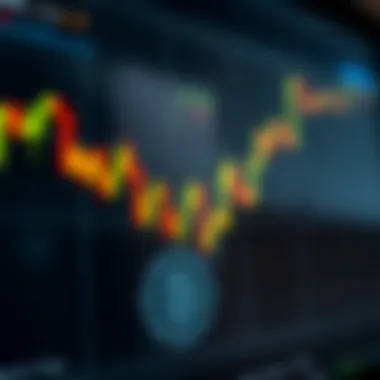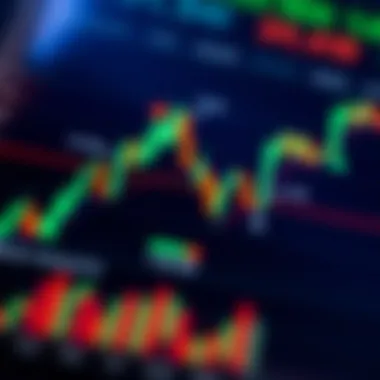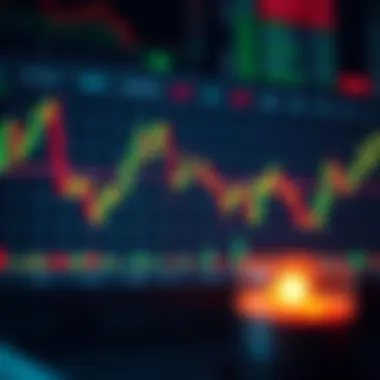Mastering Free Crypto Candlestick Charts for Trading


Intro
In the realm of cryptocurrency trading, understanding market dynamics is pivotal. When one speaks of tools that empower decision-making, free crypto candlestick charts stand out. These charts present an intricate balance of price, time, and volume, capturing the pulse of the market in a format that's not just visually captivating, but also rich in information. They are not simply tools for analysis; they are visual narratives that tell a story of market behavior, offering insights into when to enter or exit a trade.
This article will delve deeply into the crux of these candlestick charts, highlighting their key components and the strategic merit of utilizing them. We will explore how these charts can be leveraged by both novice traders and seasoned investors, aiding in navigating the highs and lows of the crypto landscape. By arming yourself with the knowledge to interpret candlestick patterns, you can enhance your trading acumen, anchoring your strategies with data-driven insights.
As the cryptocurrency market is characterized by its volatility, possessing the capability to read candlestick patterns effectively can significantly improve trading strategies. Notably, the significance of timing in this sector cannot be overstated. Candlestick charts not only allow traders to gauge price movements in real-time but also to spot trends and adjust their strategies accordingly. Therefore, understanding the nuances of these charts is paramount in today’s fast-paced trading environment.
In the upcoming sections, we will shine a light on the essential elements of crypto candlestick charts, examine how they reflect price fluctuations, and discuss valuable educational resources available for further exploration.
Preamble to Crypto Candlestick Charts
In the realm of cryptocurrency trading, understanding market movements is paramount. This is where crypto candlestick charts come into play. Instead of simply looking at prices over time, these charts offer a way to visualize market behavior, making it easier for traders to spot trends and price patterns. Their significance can't be overstated. From novice investors to seasoned professionals, everyone can extract valuable insights from these visual tools.
What Are Candlestick Charts?
Candlestick charts are graphical representations of price movements over a specific time frame. They consist of individual 'candlesticks' that each provide four crucial pieces of information: the opening price, closing price, high price, and low price for that period. Each candlestick resembles a rectangle, known as its body, with lines extending above and below, called shadows.
- If the closing price is higher than the opening price, the candlestick is often colored green, indicating bullish sentiment.
- Conversely, if the closing price is lower, it may be red, signaling bearish behavior.
For example, a single candlestick could tell a story of the market's mood in just a glance—highlighting bullish rises, bearish dips, and everything in between.
History and Evolution of Candlestick Analysis
The history of candlestick charts dates back to 18th century Japan. Japanese rice traders used them to analyze rice prices, long before Western traders adopted the practice in the 20th century. The evolution of this analytical method to modern-day crypto trading signifies the adaptability and enduring relevance of candlestick charts in the fast-paced world of economics.
Initially, the Western approach did not emphasize color coding, focusing instead on basic price movement. However, as trading evolved, so did the charting techniques, leading to the colorful and detailed charts seen today. This historical backdrop illustrates how the fundamentals of chart analysis remain robust and foundational, paving the way for their application across various markets, including cryptocurrency.
Importance in Cryptocurrency Trading
In the crypto trading space, the importance of candlestick charts cannot be emphasized enough; they offer a unique perspective on the market's psychology. Understanding these patterns can be a game changer. Here are some reasons why they matter:
- Visual Insight: Traders can quickly assess market trends beyond mere numbers.
- Predictive Power: Patterns formed by candlesticks can often signal potential market reversals or continuations, guiding traders in making informed decisions.
- Risk Management: By identifying patterns, traders can better plan their entry and exit points, helping to guard against unexpected market swings.
"Candlestick charts put a trader's emotional response to market conditions into perspective, allowing for more rational decision-making."
In summary, candlestick charts are not just a passing trend. They provide rich, actionable insights that can greatly enhance trading strategies. As we delve deeper into this guide, we'll explore their structural components, different patterns, and how to effectively apply them in the world of cryptocurrency.
Understanding the Structure of a Candlestick
When diving into the realm of cryptocurrency trading, grasping the format of a candlestick is akin to learning the building blocks of a language. Understanding what each candlestick represents can help traders decode market movements, derive insights, and make educated decisions. This part is crucial because it breaks down the visible elements of each candle and shows traders how to interpret these in the context of market activity.
Components of a Candlestick
Body
The body of a candlestick is the solid area between the open and close prices within a specified time frame. Picture it as the heart of the candle, as it gives the clearest picture of market sentiment during the period. If the body is colored or filled, it indicates that the closing price was lower than the opening price, typically signifying a bearish move. Conversely, a hollow or differently colored body suggests a bullish move, where buyers pushed prices up by the close.
- Key Characteristic: The most visible and defining part of the candlestick.
- Why it’s Beneficial: Traders use the body to get a quick glimpse of market direction—whether the bulls or bears dominated the trading session.
- Unique Feature: The size of the body reflects the price movement's strength; a longer body suggests a stronger trend, while a shorter body indicates indecision or minimal movement.
Upper Shadow
The upper shadow extends from the top of the body to the highest price reached during that time frame. This thin line gives insight into the maximum price point before sellers stepped in to push the prices down.
- Key Characteristic: Visually distinct, the upper shadow tells a story of potential resistance in the market.
- Why it’s Beneficial: It helps traders identify levels where selling pressure kicked in, which may hint at potential price reversals.
- Unique Feature: A longer upper shadow can suggest that buyer enthusiasm is fading, indicating a possible shift to bearish sentiment at a certain price level.
Lower Shadow
In contrast to its upper counterpart, the lower shadow runs from the bottom of the body to the lowest price of the candle. It shows the lowest point reached before the price bounced back up. Hence, it signifies bullish activity, reflecting unseen strength in the market despite the low point.
- Key Characteristic: It complements the body to provide a full picture of price action.
- Why it’s Beneficial: Understanding the lower shadow aids in pinpointing support levels, as it marks areas where buyers entered effectively.
- Unique Feature: A pronounced lower shadow can indicate that the price may have found a strong support, hinting at potential upward movement ahead.
Color Significance in Candlesticks
In candlestick charts, color doesn’t just serve an aesthetic purpose; it plays a vital role in conveying market sentiment. Bullish candles are usually colored green or white, while bearish ones typically appear red or black. These colors guide traders in quickly gauging price trends over different time periods.


Understanding both the components of a candlestick and their color significance arms traders with key insights into market dynamics and psychological factors, aiding in more informed trading decisions.
"A candle's wick may bend but it does not break; this resilience reflects market dynamics."
By interpreting these components accurately, traders can enhance their analysis and improve their strategy based on real-time market actions.
Different Types of Candlestick Patterns
Understanding different types of candlestick patterns is crucial for any trader looking to navigate the turbulent waters of cryptocurrency trading. These patterns serve as visual indicators, providing insights that can help forecast market movements. By identifying these signals, traders can better position themselves to take advantage of potential price rises or falls, improving their decision-making processes. Grasping these patterns not only adds to one's analytical skills but also sharpens overall trading strategy, making it an invaluable component of market analysis.
Bullish Patterns
Hammer
The hammer candlestick is a pivotal bullish pattern that usually appears at the bottom of a downtrend. It’s characterized by a small body at the top of the price range, with a long lower shadow that is at least twice the length of the body. This unique configuration signals that buyers are stepping in, attempting to push prices back up. For traders, recognizing a hammer can act as a beacon of opportunity; it suggests a potential reversal in the market sentiment. The attractiveness of the hammer lies in its simplicity and the clear message it conveys to traders about possible trend reversals. Moreover, it’s easily spotted even by novices, making it a valuable addition to one’s trading toolkit.
Engulfing Pattern
The engulfing pattern is another robust signal that occurs when a small body is fully 'engulfed' by the next larger body. When this pattern manifests at the end of a downtrend, it indicates a strong potential for upward movement. The key to this pattern is that it must occur after a bearish candle that is smaller than the bullish one that follows it. Traders often find this pattern beneficial for confirming bullish momentum and thus a likely shift in market dynamics. Its unique feature is the clear battle between buyers and sellers, making it a popular choice among traders looking for decisive market signals. However, be cautious; the significance of the pattern can sometimes be diminished if it's not supported by a substantial increase in volume.
Morning Star
The morning star is a three-candle bullish reversal pattern that signifies a shift from bearish to bullish sentiment. It consists of a long bearish candle, followed by a smaller body that moves down, and then a third bullish candle that closes above the halfway point of the first candle. The morning star often emerges in the wake of a persistent downtrend, indicating that buyers are beginning to regain control. What makes the morning star particularly enticing is its confirmation of a dramatic sentiment change, providing traders with an excellent opportunity to enter new positions. Yet, traders should remain vigilant about volume, as the absence of increased activity may yield false signals.
Bearish Patterns
Shooting Star
A shooting star is a bearish candlestick pattern that occurs after an uptrend, signaling a potential reversal. This pattern has a small body near the lower end of the price range with a long upper shadow. The story this candle tells is simple: buyers have pushed prices significantly higher during the session, but sellers quickly dragged them back down, indicating a loss of momentum. The shooting star's key characteristic is its indication of weakness in the market, making it a favored choice for those looking to short assets. However, a singular pattern shouldn’t be the sole basis for decisions; confirmation through subsequent candles and volume is essential.
Dark Cloud Cover
The dark cloud cover is a two-candle bearish reversal pattern that appears at the top of an uptrend. It starts with a bullish candle followed by a bearish candle that opens higher than the previous candle's high but closes below its midpoint. This feature portrays a strong shift in momentum, signaling that sellers are gaining ground. It's popular among traders because it encapsulates a fierce battle between buying and selling pressure, making it an effective indicator for possible market downturns. Despite its strengths, watching out for market context is vital; a standalone dark cloud cover can sometimes be misleading.
Evening Star
An evening star is another pattern that follows a similar structure to the morning star but indicates a reversal to the downside. This three-candle pattern consists of a bullish candle, followed by a smaller body that can be either bullish or bearish, and concludes with a large bearish candle. The emergence of this pattern at market peaks hints that buyers are losing interest. Traders welcome the evening star for its reliable signals of impending downtrends, but like other patterns, volume must support it for it to be truly effective. Failure to do so might lead to misinterpretations and bad trading decisions.
Indecision Patterns
Doji
A doji is a unique candlestick pattern that can appear in various market conditions, but it typically indicates indecision. The doji is characterized by its small body, where the open and close prices are almost equal, resulting in shadows that can vary in size. What makes the doji significant is its representation of the conflict between buyers and sellers; it suggests that neither side was able to control the session. This characteristic makes it a popular choice for traders, as it hints at potential reversals when found at significant support or resistance levels. Yet, a doji on its own doesn’t provide a clear direction and should ideally be confirmed by subsequent price movements.
Spinning Top
The spinning top is another indecision pattern, similar to the doji, but with a slightly larger body. It features a small body and long upper and lower shadows, signaling uncertainty among market participants. This pattern commonly appears after a bullish or bearish trend, indicating that traders are weighing their options before making the next move. Recognizing a spinning top can be beneficial, as it hints at potential forthcoming volatility, allowing traders to adjust their positions accordingly. However, just like with the doji, relying solely on this pattern without supporting indicators can lead to misleading conclusions.
Applications of Candlestick Charts in Crypto Trading
In the fast-paced world of cryptocurrency trading, candlestick charts serve as a vital tool for traders, providing a visual representation of price movements over time. Understanding how to apply these charts effectively can make significant differences in trading decisions. Their applications stretch beyond mere chart reading, encompassing various strategies and insights that can enhance one’s trading experience.
Technical Analysis and Decision-Making
Technical analysis relies heavily on historical price data to forecast future movements. Candlestick charts allow traders to observe price fluctuations through distinct time frames, giving them the ability to uncover potential buying or selling opportunities. For instance, when a trader spots a bullish engulfing pattern within the context of an upward trend, it may signal a potent opportunity to enter the market. This visible compression of price action translates into actionable intelligence, allowing for more informed decisions.
When it comes to decision-making, integrating candlestick charts with other indicators can bolster a trader's confidence. For instance, overlaying moving averages onto candlestick charts can help clarify the overall trend direction, while RSI (Relative Strength Index) can depict whether an asset is overbought or oversold. Both sets of insights inform more nuanced entry and exit points, ultimately enhancing the likelihood of successful trades.
Identifying Trends and Reversals
Identifying trends is another crucial application of candlestick charts. These visual tools can help traders recognize whether a market is moving upward, downward, or sideways. For example, a series of higher highs and higher lows, illustrated by a string of ascendant candlesticks, clearly indicates an upward trend. Conversely, a series of lower highs and lower lows represents bearish momentum.
Moreover, one of the most powerful aspects of candlestick patterns is their capacity to signify trend reversals. A doji candlestick, for example, often emerges in conditions of market indecision, hinting that the trend might be about to shift. Recognizing such patterns early can provide traders with a crucial edge when positioning their trades, allowing for capitalizing on potential turning points before they gain momentum.
Enhancing Risk Management Strategies
In trading, risk management is paramount. Candlestick charts provide a feasible way to manage risks effectively by establishing stop-loss orders based on price action. An astute trader may decide to set a stop-loss just below a previously established support level marked by a candlestick's low. This allows for minimizing losses while simultaneously enabling participation in potentially lucrative trades.


Moreover, analyzing volume alongside candlestick formations can yield deeper insights into price movements. Higher trading volume accompanying a candlestick pattern can indicate the strength of a move, hence influencing how to approach risk management. For instance, a bullish pattern confirmed by rising volume may incentivize a trader to hold their position, knowing that the momentum is underscored by solid trading activity.
"Effective risk management is not just a routine; it's a lifeline in volatile markets like crypto."
To sum up, the applications of candlestick charts extend far beyond mere aesthetics; they offer actionable insights that enhance decision-making, trend identification, and risk management strategies. By comprehending these applications, traders can navigate the crypto landscape with greater accuracy and confidence, making the most of highly volatile market conditions.
Where to Find Free Crypto Candlestick Charts
Finding reliable sources for free crypto candlestick charts is essential for traders seeking to make informed decisions. These charts provide vital insights into price trends and market sentiment. By knowing where to locate these resources, traders can effectively analyze market movements, identify entry and exit points, and enhance their overall trading strategies.
Popular Platforms Offering Free Charts
TradingView
TradingView stands out as one of the most popular platforms for candlestick analysis. With its robust suite of tools, it allows users to create custom charts tailored to their needs. The platform is particularly known for its user-friendly interface, which caters to both novices and experienced traders alike. One of the key features of TradingView is its vast community. Users can share their analyses and strategies, providing a collaborative atmosphere for learning and improvement.
However, a slight drawback is that while many features are free, some advanced tools might require a subscription, which could deter casual users seeking to start without any investment. Overall, TradingView remains a beneficial choice for analyzing candlestick patterns and accessing a wealth of shared knowledge from fellow traders.
Coinigy
Coinigy is another notable platform that offers a comprehensive array of tools for cryptocurrency trading, including free candlestick charting options. One significant aspect is its ability to connect to multiple exchanges, allowing users to monitor real-time prices across various platforms. This capability is crucial for traders who operate across different exchanges.
The standout characteristic of Coinigy is its seamless integration with multiple wallets, making it a favored choice for those who want to manage their portfolios efficiently. However, it’s worth noting that some functionalities are not available without a paid subscription. Despite this limitation, Coinigy remains a popular tool for serious traders seeking detailed candlestick analysis.
CryptoCompare
CryptoCompare has been a reliable source in the crypto community, offering a wealth of information including free candlestick charts. This platform’s unique selling point is its in-depth cryptocurrency comparison feature, which can be useful for identifying trends among different cryptocurrencies. Additionally, it provides historical data that helps traders analyze past performance, an important aspect of making well-informed trading decisions.
One interesting feature of CryptoCompare is its community-driven data, which can occasionally provide new insights that larger platforms may overlook. However, the interface may not be as sleek as others, leading to a steeper learning curve for those who are not tech-savvy. Nevertheless, CryptoCompare is valuable for those looking to thoroughly assess various market conditions through candlestick charts.
Mobile Apps for Instant Access
In today's fast-paced trading environment, having access to information on-the-go is critical. Mobile apps serve as essential tools for traders who need to keep an eye on market movements while away from their desks.
Blockfolio
Blockfolio is a widely used mobile app that offers portfolio tracking features alongside free candlestick charts. One of its most attractive aspects is the real-time notifications it sends users about price movements. This ensures traders can react quickly to market changes without constantly having to check their screens.
A key characteristic of Blockfolio is its user-friendly layout, which simplifies monitoring a diverse array of cryptocurrencies. However, while it excels in tracking and notifications, it may not provide as advanced analytical tools as desktop platforms. Nonetheless, Blockfolio serves as an excellent choice for quick insights and portfolio management on the go.
Delta
Delta is another noteworthy mobile application facilitating real-time access to cryptocurrency market data, including candlestick charts. Its design appeals to both casual traders and those who are more metrics-driven. The standout feature is its ability to aggregate information from various exchanges to provide users with a comprehensive view of their investments.
Delta’s versatility is another of its strong points, with options to import data manually or synchronize with various exchanges. However, some users report that it can lack certain predictive tools found on more comprehensive platforms. Still, Delta is a fantastic option for monitoring market trends while remaining mobile.
CoinMarketCap
CoinMarketCap has evolved from a simple tracking tool into a full-fledged mobile app providing market data and candlestick charts. The app’s straightforward and clean design makes it easy to navigate while still delivering critical market insights.
A significant feature is its extensive database of cryptocurrencies, allowing users to look up virtually any asset and check its performance using candlestick charts. However, the app does face criticism for its occasional lag in real-time data during periods of high volatility. Even so, CoinMarketCap remains an essential resource for anyone wanting to stay updated with market trends.
In summary, locating free crypto candlestick charts involves identifying reliable platforms that cater to your specific needs. From comprehensive desktop applications like TradingView and Coinigy to versatile mobile apps like Blockfolio and Delta, there are numerous excellent options to enhance your trading strategy.
Best Practices for Reading Candlestick Charts
Reading candlestick charts effectively is both an art and a science. For anyone looking to thrive in the bustling world of cryptocurrency trading, mastering this skill offers distinct advantages. Understanding the patterns formed by these charts allows traders to make decisions based on visual data rather than emotions, providing a more streamlined approach to navigating market fluctuations. Here, we'll explore practical strategies that can enhance the interpretation of candlestick charts and bolster your trading strategies.
Establishing Context With Volume Analysis
To truly grasp the significance of a candlestick pattern, combining it with volume analysis is a game changer. Volume refers to the number of shares or contracts traded for a specified security over a period of time. When evaluating a candlestick, it’s vital to consider the volume behind the movement.
For instance, a bullish engulfing pattern may seem promising, but if it appears with low volume, it could be a false signal. On the other hand, a significant increase in volume can validate a candlestick’s indication. The key here is to look for trends:
- High volume on upward movements can indicate strong buying interest.
- High volume during a price decline might signal strong selling pressure.


By marrying candlestick patterns with volume, traders can establish a stronger framework for their decisions and avoid being led astray by random price movements.
Combining Candlesticks With Other Indicators
Moving Averages
Moving averages (MA) are one of the most popular tools traders employ alongside candlestick charts. They smooth out price data by creating a constantly updated average price. The simplicity of moving averages makes them a favored choice for many in the trading arena. A key characteristic of moving averages is their ability to highlight trends over specific time frames, allowing traders to discern the underlying direction of a market.
However, basing decisions solely on moving averages might not be ideal. For example, they can lag behind the market, particularly in a volatile environment. Traders typically use both a short-term and a long-term moving average to create crossovers, which can signal entry and exit points. Understanding how these averages interplay with candlestick signals can create a powerful combinational strategy.
RSI
The Relative Strength Index (RSI) is another essential indicator that works well with candlestick analysis. It measures the speed and change of price movements on a scale of 0 to 100. An RSI above 70 can indicate that a cryptocurrency is overbought, while an RSI below 30 suggests it is oversold. The integration of RSI with candlestick patterns can give traders critical insight into market momentum and potential reversals.
One aspect that makes RSI particularly beneficial is its ability to identify divergence. For instance, if prices are making higher highs while RSI shows lower highs, it could indicate a potential reversal. Nevertheless, depending solely on RSI can be risky, especially in trending markets where the index can remain in overbought or oversold territories for extended periods.
MACD
The Moving Average Convergence Divergence (MACD) is another versatile tool that can amplify the analysis of candlestick charts. It indicates the relationship between two moving averages. Traders often watch for the MACD line crossing above or below the signal line as a cue for potential buy or sell signals.
What’s particularly intriguing about the MACD is its ability to highlight both momentum and trend direction. A strong MACD reading, when combined with a clear candlestick pattern, can signal a robust trading opportunity. However, a noted disadvantage is that MACD can sometimes produce late signals during swift market changes.
Avoiding Common Misinterpretations
From time to time, even seasoned traders can misinterpret candlestick patterns. One common pitfall is over-relying on a single candle’s signals without considering the broader context. Just because a candlestick pattern appears doesn’t mean it will play out; traders must analyze it within a larger framework of price action and market conditions.
Additionally, dismissing the role of external factors – such as news events or market sentiment – can lead to incorrect conclusions. Always keep in mind that candlesticks provide a snapshot of market activity, but understanding the environment around them is crucial.
"In trading, you must see the picture as a whole, combining art and science for clear insights."
By adhering to these best practices, traders can elevate their ability to read and interpret candlestick charts, making for a more informed trading strategy.
Limitations of Candlestick Analysis
Understanding the limitations of candlestick analysis is as vital as mastering the charts themselves. While these visual tools are powerful for making trading decisions, they aren't infallible. It’s crucial for traders to recognize the potential pitfalls to enhance their strategies and avoid costly mistakes in the volatile crypto marketplace.
Market Volatility and False Signals
One significant limitation lies in market volatility. The cryptocurrency market, known for its unpredictable price swings, can lead to false signals in candlestick patterns. For instance, a bullish engulfing pattern may appear during a price uptick only for the market to unexpectedly reverse direction minutes later.
"> "False signals can lead traders to make hasty decisions based on incomplete information."
In layman terms, if you see a big green candle, you might think the price is set to soar, but sometimes it can simply be a market overreaction. A candlestick pattern can look promising, but sharp price fluctuations can turn a seemingly solid trade into a bad bet. Therefore, it's essential to complement candlestick charts with other analytical tools to validate your observations.
Dependence on Historical Data
Another limitation of candlestick analysis is its heavy reliance on historical data. Traders often use past patterns to predict future movements, but this premise can fail under changing market conditions. Just because a hammer pattern worked perfectly five times before doesn’t guarantee success the next time it appears.
The crypto space is ever-changing. Fundamental factors such as regulatory news, technological advancements, and market sentiment can disrupt established patterns. This means that relying solely on historical data can be a double-edged sword. Traders need to combine it with current market conditions and broader economic indicators to make well-informed decisions.
In summary, while candlestick analysis can provide valuable insights, a one-dimensional approach can lead to misguided trades. Awareness of these limitations is essential for anyone looking to succeed in cryptocurrency trading.
The End
In wrapping up this comprehensive guide, it’s clear that free crypto candlestick charts offer traders and investors a powerful means to visualize market conditions. The act of interpreting these charts isn’t just for seasoned experts; even novices can harness their potential with a bit of practice and understanding.
Recap of Key Insights
A few essential insights from this article can significantly shape your approach:
- Foundation of Analysis: Candlestick charts provide critical insights into market trends through their unique structures. Understanding the components, such as the body, upper, and lower shadows, creates a solid groundwork for analysis.
- Pattern Recognition: Identifying various candlestick patterns—whether bullish, bearish, or indecisive—empowers traders to anticipate potential price movements, thereby steering their strategic decisions.
- Adaptation and Flexibility: One of the most valuable aspects of these charts is their adaptability across different market conditions. Whether the market is heading upwards, downward, or sideways, traders can use candlestick analysis to refine their strategies.
"The beauty of candlestick charts lies in their simplicity; a single glance can provide a wealth of information."
Each trader’s learning journey with candlesticks is unique and requires an investment of time and energy. Familiarity with market volatility, combined with historical data, enriches one’s ability to make informed decisions.
Looking Ahead: The Future of Candlestick Analysis in Crypto
As the cryptocurrency market continues to evolve, so too does the use of candlestick charts in trading strategies. Innovations in charting software likely mean that features will become even more advanced, enabling more detailed analysis. Here are some possible future trends in candlestick analysis:
- Integration with AI and Machine Learning: Tools that analyze past price movements could soon be enhanced with AI capabilities, identifying patterns more accurately and in real-time.
- Cross-Platform Accessibility: As mobile apps develop, traders will find themselves having better access to detailed charts on-the-go, ensuring they can act on market opportunities.
- Education and Community Building: Online forums and educational resources tailored towards novice and expert traders alike will foster a better understanding of these tools, empowering a new generation of traders.
In summary, while we’ve concluded our exploration here, the journey into the realm of candlestick charts is merely beginning for many. By leveraging the resources at one’s disposal, from free charts to community insights, traders can not only stay afloat amidst market fluctuations but also ride the waves of opportunity that come their way.



